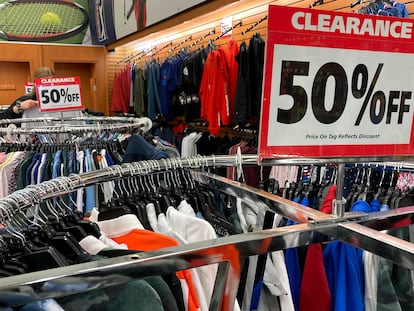Fewer Americans apply for jobless benefits, as labor market still showing strength
The U.S. economy has added jobs at a breakneck pace despite interest rates that have been rising for more than a year and fears of a looming recession

Fewer Americans applied for jobless benefits last week after a previous spike that some took as a sign that higher interest rates were finally cooling the labor market. Applications for jobless claims for the week ending May 6 fell by 22,000 to 242,000, from 264,000 the week before, the Labor Department reported Thursday. The weekly claims numbers are broadly as representative of the number of U.S. layoffs.
The four-week moving average of claims, which flattens some of the week-to-week fluctuations, ticked down by 1,000 to 244,250. Analysts have pointed to a sustained increase in the four-week averages as a sign that layoffs are accelerating, but are reluctant to predict that a spike in layoffs is imminent.
Overall, 1.8 million people were collecting unemployment benefits the week that ended April 29, about 8,000 fewer than the previous week.
Since the pandemic purge of millions of jobs three years ago, the U.S. economy has added jobs at a breakneck pace and Americans have enjoyed unusual job security. That’s despite interest rates that have been rising for more than a year and fears of a looming recession.
Early this month, the Fed raised its benchmark lending rate for the 10th time in a row in its bid to cool the economy and bring down four-decade high inflation. Though the labor market still favors workers, there have been some recent indications that the Fed’s policy actions are working.
In April, U.S. employers added a healthy 253,000 jobs and the unemployment rate dipped to 3.4%, matching a 54-year low. But the figures for February and March were revised lower by 149,000 jobs, potentially signaling that the Fed’s rate policy strategy is starting to cool the job market.
The government also recently reported that U.S. job openings fell in March to the lowest level in nearly two years.
The Fed is hoping to achieve a so-called soft landing — lowering growth just enough to bring inflation under control without causing a recession. Economists are skeptical, with many expecting the U.S. to enter a recession later this year.
Last month, the Commerce Department reported that the U.S. economy slowed sharply from January through March, decelerating to just a 1.1% annual pace as higher interest rates hammered the housing market and businesses reduced inventories.
There have been an increasing number of high-profile layoffs recently, mostly in the technology sector, where companies added jobs at a furious pace during the pandemic. IBM, Microsoft, Salesforce, Twitter, Lyft, LinkedIn and DoorDash have all announced layoffs in recent months. Amazon and Facebook have each announced two sets of job cuts since November.
But it’s not just the tech sector that’s trimming staff. McDonald’s, Morgan Stanley and 3M also announced layoffs recently.
Sign up for our weekly newsletter to get more English-language news coverage from EL PAÍS USA Edition
Tu suscripción se está usando en otro dispositivo
¿Quieres añadir otro usuario a tu suscripción?
Si continúas leyendo en este dispositivo, no se podrá leer en el otro.
FlechaTu suscripción se está usando en otro dispositivo y solo puedes acceder a EL PAÍS desde un dispositivo a la vez.
Si quieres compartir tu cuenta, cambia tu suscripción a la modalidad Premium, así podrás añadir otro usuario. Cada uno accederá con su propia cuenta de email, lo que os permitirá personalizar vuestra experiencia en EL PAÍS.
¿Tienes una suscripción de empresa? Accede aquí para contratar más cuentas.
En el caso de no saber quién está usando tu cuenta, te recomendamos cambiar tu contraseña aquí.
Si decides continuar compartiendo tu cuenta, este mensaje se mostrará en tu dispositivo y en el de la otra persona que está usando tu cuenta de forma indefinida, afectando a tu experiencia de lectura. Puedes consultar aquí los términos y condiciones de la suscripción digital.
More information
Archived In
Últimas noticias
Most viewed
- Sinaloa Cartel war is taking its toll on Los Chapitos
- Oona Chaplin: ‘I told James Cameron that I was living in a treehouse and starting a permaculture project with a friend’
- Reinhard Genzel, Nobel laureate in physics: ‘One-minute videos will never give you the truth’
- Why the price of coffee has skyrocketed: from Brazilian plantations to specialty coffee houses
- Silver prices are going crazy: This is what’s fueling the rally










































